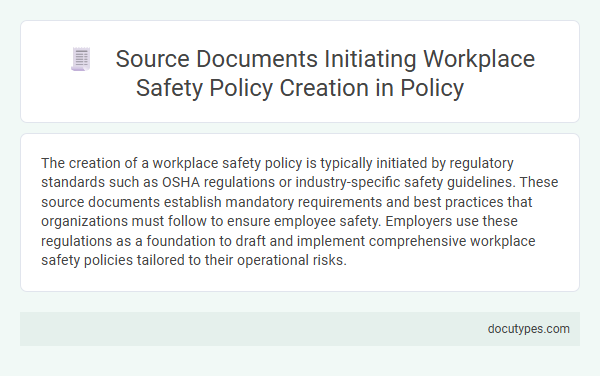The creation of a workplace safety policy is typically initiated by regulatory standards such as OSHA regulations or industry-specific safety guidelines. These source documents establish mandatory requirements and best practices that organizations must follow to ensure employee safety. Employers use these regulations as a foundation to draft and implement comprehensive workplace safety policies tailored to their operational risks.
Introduction to Source Documents in Workplace Safety Policy
Which source document initiates the creation of a workplace safety policy? The primary source document is typically the Occupational Safety and Health Administration (OSHA) regulations or similar governmental safety standards. These documents provide the legal framework and essential guidelines that shape the development of your workplace safety policy.
Regulatory Frameworks Governing Safety Policy Creation
| Source Document | Description | Role in Workplace Safety Policy Creation |
|---|---|---|
| Occupational Safety and Health Act (OSHA) | Federal law mandating safe working conditions in the United States. | Primary regulatory framework requiring employers to develop and implement workplace safety policies. |
| National Safety Standards | Published by organizations such as ANSI (American National Standards Institute) and NFPA (National Fire Protection Association). | Provide detailed guidelines and technical criteria that inform safety policy structure and procedures. |
| Industry-Specific Regulations | Rules established by regulatory bodies like the Environmental Protection Agency (EPA) and Mine Safety and Health Administration (MSHA). | Set specialized safety requirements tailored to particular sectors influencing workplace safety policies. |
| State Safety Regulations | State-level laws and standards complementing federal regulations. | May impose more stringent safety requirements, affecting the scope and detail of workplace safety policies. |
| Risk Assessments and Incident Reports | Internal documents analyzing workplace hazards and previous safety incidents. | Serve as foundational sources guiding the development of targeted, effective safety policies. |
Occupational Health and Safety Acts as Primary Sources
The creation of a workplace safety policy is primarily initiated by Occupational Health and Safety Acts. These legal documents establish mandatory standards and guidelines to protect worker health and safety.
- Occupational Health and Safety Acts - Serve as primary sources that mandate the development of workplace safety policies.
- Regulatory Compliance - Your workplace safety policy must comply with the specific provisions outlined in these acts.
- Legal Framework - These acts provide the foundation for occupational safety regulations and enforcement.
Industry Standards and Best Practice Guidelines
The creation of a workplace safety policy is primarily initiated by industry standards set by recognized organizations such as OSHA (Occupational Safety and Health Administration) and ISO (International Organization for Standardization). These standards provide a foundational framework that ensures compliance with legal requirements and promotes a safe working environment.
Best practice guidelines from industry experts and trade associations also play a crucial role in shaping workplace safety policies. These documents offer practical recommendations and proven strategies that enhance safety measures beyond regulatory mandates, tailored to specific industry risks and operational contexts.
Internal Incident Reports and Safety Audits
The creation of a workplace safety policy often begins with detailed internal incident reports. These reports provide critical insights into past accidents and near-misses, highlighting areas requiring enhanced safety measures.
Safety audits serve as another vital source document that initiates policy development. They offer a comprehensive evaluation of current safety practices, identifying gaps and recommending improvements to ensure regulatory compliance and employee protection.
Insurance Requirements and Risk Assessment Documents
The creation of a workplace safety policy is primarily initiated by insurance requirements that outline mandatory safety standards and compliance measures. Risk assessment documents play a crucial role by identifying potential hazards and guiding the development of targeted safety protocols. Your company must review these source documents carefully to ensure the policy addresses all relevant safety and insurance criteria effectively.
Employee and Stakeholder Feedback Records
Employee and stakeholder feedback records serve as a critical source document for initiating the creation of a workplace safety policy. These records provide valuable insights into real workplace hazards, employee concerns, and areas requiring safety improvements. Incorporating this feedback ensures the policy addresses actual risks and promotes a safer work environment for all stakeholders.
Lessons Learned from Previous Workplace Incidents
The source document that initiates the creation of a workplace safety policy is the record of lessons learned from previous workplace incidents. This document highlights critical safety failures and provides concrete data for policy development.
Lessons learned from past incidents offer detailed insights into hazards and risks encountered in the workplace. These findings guide the formulation of targeted safety measures and preventative strategies. Incorporating this evidence ensures the workplace safety policy addresses real, documented issues effectively.
External Consultation Reports and Expert Recommendations
Workplace safety policies are often initiated based on critical external consultation reports and expert recommendations that identify key risks and regulatory requirements. These source documents provide authoritative guidance to ensure compliance and enhance worker protection measures.
- External Consultation Reports - Comprehensive analyses by third-party safety consultants highlight current workplace hazards and recommend tailored safety protocols.
- Expert Recommendations - Insights from occupational health and safety experts inform the development of policies that address emerging risks and best practices.
- Regulatory Alignment - These documents ensure the policy conforms to national safety standards and legal obligations, minimizing organizational liability.
Which Source Document Initiates the Creation of a Workplace Safety Policy? Infographic

